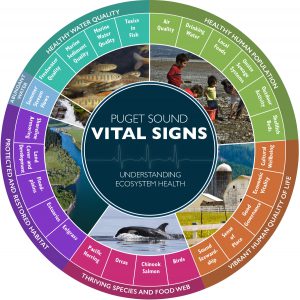In 2017, the Northwest Straits Foundation, Skagit Marine Resources Committee, Washington State Parks, and Skagit Fisheries Enhancement Group completed a restoration project at the beach at Bowman Bay in Deception Pass State Park. The purpose of the project was to remove a line of large rocks—which is known as rip-rap—from the shoreline and return the beach to a more natural state.
“There had been shoreline armor or rip-rap, so a line of rock, large rock, along the shoreline that had been put in to support a fish hatchery here and when the hatchery closed, that rock was no longer necessary,” said Lisa Kaufman, nearshore program manager for the Northwest Straits Foundation.
Bowman Bay provides habitat for surf smelt, bull trout, and juvenile salmon. By restoring the beach, the project partners opened up the shoreline to natural processes. This improves the quality of the habitat for fish and other wildlife species. The project also improved access for park visitors to enjoy the beach.
“If this beach had not been restored, it would be a desert,” said Jack Hartt, retired manager of Deception Pass State Park. “The wildlife could not come in from the beach. Humans cannot come down from the top. It would be a place that is devoid of life.”
During the restoration, the project partners removed 2000 tons of rip-rap, reshaped the beach, added sand and gravel to the shoreline, and put in new plants at the site.
Bowman Bay is within Samish Indian Nation traditional territory and holds significance for the tribe. The Samish Indian Nation supported the restoration project. Representatives from the tribe assisted at the project site for cultural and archeological purposes. Bowman Bay is close by Rosario Beach, which is the location of the Maiden of Deception Pass story pole. The wooden carving of the Maiden of Deception Pass represents Ko-Kwal-Alwoot, a Samish woman whose story is important for the Samish Indian Nation. Leslie Eastwood, Samish citizen and general manager for the Samish Indian Nation, tells the story of Ko-Kwal-Alwoot in the video below.
After the completion of the Bowman Bay restoration project, the Washington State Department of Fish and Wildlife (WDFW) and Salish Sea Stewards have monitored the beach to see how the habitat has changed and how it’s being used. During the summer of 2019, volunteers found surf smelt eggs in samples they collected from Bowman Bay beach. The last time WDFW found surf smelt eggs at Bowman was in 2003.
“By pulling out the rip-rap and giving ourselves a natural shoreline, we’re able to restore it for forage fish habitat,” said Jason Morgan, marine projects manager at Northwest Straits Foundation. “We now have surf smelt spawning on the beaches, and we’ve now created a beach that has less wave energy, and also has plants that can feed insects into the water for juvenile salmon who come and use these sheltered bays.”
Todd Woodard, natural resources director with the Samish Indian Nation, summed up the success of the project. “Human use and natural processes can work together and exist together,” he said. “It’s not an either-or situation. It’s how can both things exist in harmony and be in balance, and I think this project does that quite well.”
Thanks to the Bowman Bay Nearshore Restoration Project funders and partners:
· Washington State Department of Natural Resources’ and Washington State Department of Fish and Wildlife’s Puget Sound Marine and Nearshore Grant Program
· U.S. Environmental Protection Agency
· Washington Department of Fish and Wildlife’s Estuary Salmon Restoration Program
· Northwest Straits Commission
· Skagit Marine Resources Committee
· Puget Sound Partnership
· Alcoa Foundation
· National Estuary Program Habitat Strategic Initiative
· Northwest Straits Foundation
· Samish Indian Nation
· Washington State Department of Natural Resources’ Puget Sound Corps
· Skagit Fisheries Enhancement Group
· Washington State Parks
Vital Sign connections

The Vital Signs measure the health of Puget Sound and progress toward its recovery.
Shoreline Armoring
Shoreline armoring is the practice of using seawalls or rip-rap to protect public and private property. Shoreline armoring disrupts the natural process of erosion, which supplies much of the sand and gravel that forms and maintains beaches and creates habitat for many other species. The Bowman Bay Nearshore Restoration Project removed shoreline armoring from the beach and restored it to a more natural state to improve the habitat.
Chinook Salmon
Juvenile salmon depend on sheltered habitats like Bowman Bay. The project partners restored the Bowman Bay beach to a more natural state and planted more vegetation at the site. More vegetation provides better habitat for insects, which increases the amount of prey available for juvenile salmon.
Sound Stewardship
Puget Sound residents engage in environmental stewardship activities that they perceive as meaningful to themselves, their community, and the environment. Salish Sea Stewards and other volunteers have helped monitor the condition of the Bowman Bay restoration site for several years. The volunteers’ monitoring efforts were responsible for detecting the presence of surf smelt eggs on the Bowman Bay beach.
Pacific Herring
Forage fish—which are small schooling fish like surf smelt or Pacific herring—play a unique role in the food web of the Salish Sea. They are an essential food source for larger fish, seabirds, and marine mammals. Forage fish depend on clean water and natural shorelines. The Bowman Bay Nearshore Restoration Project removed shoreline armoring and transformed the Bowman Bay beach into a natural shoreline again, which has improved the habitat available for forage fish at Bowman Bay.

